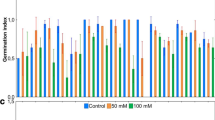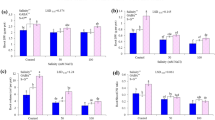Abstract
Knowledge of relationships between physiological parameters and growth performance of seedlings and respective genotypic differences would permit selection of salt tolerance at early growth stages. The goals of this study were to investigate the relationships between physiological parameters and growth performance and quantify the respective genotypic differences using multivariate analysis.. Plants of thirty-one genotypes were grown in sand tanks in a greenhouse and irrigated with Yoshida nutrient solution. Two salinity treatments were imposed at 0.9 dSm−1 (control) and 6.4 dSm−1 with sodium chloride and calcium chloride (~ 6: 1 molar ratio). Seedlings were sampled 34 days after planting (7th to 8th leaf stage). The characters of Na+, K+, Ca2+, K-Na selectivity (SK,Na) and Na-Ca selectivity (SNa,Ca) were measured as physiological parameters. The characters of tiller number, leaf area, plant height and shoot dry weight were measured as growth performance. Under salinity stress, SK,Na increased whereas SNa,Ca decreased compared to the controls. Canonical correlation analysis indicates a strong relationship between physiological parameters and growth performance. Tiller number is a desirable parameter among the growth parameters analyzed to predict seedling growth under salinity stress. Genotypes grouped into four clusters based on ion contents and ion selectivity using Ward’s minimum-variance cluster analysis. SK,Na and shoot Na+ content contributed the most to the cluster formation. Similarly, genotypes grouped into four clusters based on growth performance. Ge notypes were classified into three categories based on ion cluster rankings: Category 1 with high SK,Na and low shoot Na+ content; Category 2 with intermediate SK,Na and shoot Na+ content; Category 3 with low SK,Na and high shoot Na+ content. The classification of the genotypes into Categories 1 and 3 based on their high or low SK,Na was generally consistent with their growth performance under salt stress. In contrast, ion selectivity was a less dominant mechanism controlling salt tolerance in Category 2 with intermediate SK,Na. It was concluded that ion selectivity was a relatively dominant mechanism controlling salt tolerance among rice genotypes although multiple mechanisms may be involved under moderate salt stress. The results also provide the first example of the effectiveness of cluster analysis for physiological responses to salinity stress.
Similar content being viewed by others
Abbreviations
- SK,Na:
-
K-Na selectivity
- SNa,Ca:
-
Na-Ca selectivity
- DAP:
-
days after planting
References
F Asch M Dingkuhn K. Dörffling K Mièzan (2000) ArticleTitleLeaf K/Na ratio predicts salinity induced yield loss in irrigated rice Euphytica 113 109–118
M Aslam T J Flowers R H Qureshi A R Yeo (1996) ArticleTitleInteraction of phosphate and salinity on the growth and yield of rice (Oryza sativa L.). J Agron. Crop Sci 176 249–258 Occurrence Handle1:CAS:528:DyaK28XltlCgtLw%3D
M Aslam N Muhammad R H Qureshi Z Ahmad S Mawaz J Akhtar (2003) ArticleTitleCalcium and salt-tolerance of rice Commu. Soil Sci. Plant Anal 34 3013–3031 Occurrence Handle1:CAS:528:DC%2BD3sXotFekurc%3D
J Crossa K Basford S Taba I DeLace E Silva (1995) ArticleTitleThree mode analyses of maize using morphological and agronomic attributes measured in multilocation trials Crop Sci 35 1483–1491
T J Flowers A R Yeo (1981) ArticleTitleVariability in the resistance of sodium chloride salinity within rice (Oryza sativa L.) varieties New Phytol 88 363–373 Occurrence Handle1:CAS:528:DyaL3MXlt12ksL8%3D
J Franco J Crossa J Villaseñor S Taba S A Eberhart (1999) ArticleTitleA two-stage, three-way method for classifying genetic resources in multiple environments Crop Sci 39 259–267
J Franco J Crossa S Taba H Shands (2003) ArticleTitleA multivariate method for classifying cultivars and studying group × environment × trait interaction Crop Sci 43 1249–1258
J Gorham GW Jones (2002) Genetics of salinity responses and plant breeding A Läuchli U Lüttge (Eds) Salinity: Environment-Plant-Molecules Kluwer Academic Publishers Boston 451–489
SR Grattan L Zeng MC Shannon SR Roberts (2002) ArticleTitleRice is more sensitive to salinity than previously thought California Agricult 56 189–195
G B Gregorio D Senadhira R D Mendoza N L Manigbas J P Roxas C Q Querta (2002) ArticleTitleProgress in breeding for salinity tolerance and associated abiotic stresses in rice Field Crops Res 76 91–101
L T Jolliffe O B Allen B R Christie (1989) ArticleTitleComparison of variety means using cluster analysis and dendrograms Expl. Agric 25 259–269
S Khatun C A Rizzo T J Flowers (1995) ArticleTitleGenotypic variation in the effect of salinity on fertility in rice Plant Soil 173 239–250 Occurrence Handle1:CAS:528:DyaK2MXnvVelu7s%3D
T Khrais Y Leclerc D J Donnelly (1998) ArticleTitleRelative salinity tolerance of potato cultivars assessed by in vitro screening Amer. J. Potato Res 75 207–210
H R Khan K F Yasmin T Adachi I Ahmed (1992) ArticleTitleEffects of gypsum, Zn, and intermittent saline irrigation on the growth, yield, and nutrition of rice plants grown in a saline soil Soil Sci. Plant Nutri 38 421–429 Occurrence Handle1:CAS:528:DyaK3sXjvVWhsw%3D%3D
K S Lee W Y Choi J C Ko T S Kim G B Gregorio (2003) ArticleTitleSalinity tolerance of japonica and indica rice (Oryza sativa L.) at the seedling stage Planta 216 1043–1046 Occurrence Handle1:CAS:528:DC%2BD3sXjvFGjt74%3D Occurrence Handle12687373
S Lutts J M Kinet J Bouharmont (1995) ArticleTitleChanges in plant response to NaCl during development of rice (Oryza sativa L.) varieties differing in salinity resistance J. Exp. Bot 46 1843–1852 Occurrence Handle1:CAS:528:DyaK28XlsFeguw%3D%3D
R Munns (2002) ArticleTitleComparative physiology of salt and water stress Plant Cell Environ 25 239–250 Occurrence Handle10.1046/j.0016-8025.2001.00808.x Occurrence Handle1:CAS:528:DC%2BD38Xhslakurw%3D Occurrence Handle11841667
M G Pitman (1976) Ion uptake by plant roots U Lüttge M G Pitman (Eds) Encyclopedia of Plant Physiology, Vol.2. Transport in Plants II. Part B. Tissues and Organs Springer-Verlag Berlin 95–128
A Qadar (1995) ArticleTitleRequirement of rice crop for phosphorus and potassium at varying sodicity levels J. Plant Nutri 18 2291–2303 Occurrence Handle1:CAS:528:DyaK2MXps1yrtLc%3D
C Quijano-Guerta G J D Kirk (2002) ArticleTitleTolerance of rice germplasm to salinity and other soil chemical stresses in tidal wetland Field Crop Res 76 111–121
InstitutionalAuthorNameSAS Institute Inc (1994) SAS/STAT User’s Guide EditionNumber4 SAS Institute Inc Cary NC
I Schlösser J Kranz J M Bonman (2000) ArticleTitleMorphological classification of traditional Philippine upland rice cultivars in upland nurseries using cluster analysis methods for recommendation, breeding and selection purposes J. Agron. Crop Sci 184 165–171
G Sposito (1981) The Thermodynamics of Soil Solutions Oxford University Press Oxford
A R Yeo T J Flowers (1985) ArticleTitleThe absence of an effect of the Na/Ca ratio on sodium chloride uptake by rice (Oryza sativa L.) New Phytol 99 81–90 Occurrence Handle1:CAS:528:DyaL2MXhs1Wksrs%3D
A R Yeo T J Flowers (1986) ArticleTitleSalinity resistance in rice (Oryza sativa L.) and a pyramiding approach to breeding varieties for saline soils Austr. J. Plant Physiol 13 161–174
A R Yeo M E Yeo T J Flower (1987) ArticleTitleThe contribution of an apoplastic pathway to sodium uptake by rice roots in saline conditions J. Exp. Bot 38 1141–1153 Occurrence Handle1:CAS:528:DyaL1cXlt1ylug%3D%3D
AR Yeo ME Yeo SA Flowers TJ Flowers (1990) ArticleTitleScreening of rice (Oryza sativa L.) genotypes for physiological characters contributing to salinity resistance, and their relationship to overall performance Theor. Appl. Genet 79 377–384
S Yoshida D A Forno J H Cock (1971) Laboratory Manual for Physiological Studies of Rice International Rice Research Institute Los Banos, Laguna, Philippines
L Zeng M C Shannon (2000) ArticleTitleSalinity effects on seedling growth and yield components of rice Crop Sci 40 996–1003
L Zeng M C Shannon C M Grieve (2002) ArticleTitleEvaluation of salt tolerance in rice genotypes by multiple agronomic parameters Euphytica 127 235–245 Occurrence Handle1:CAS:528:DC%2BD38XntVKqsrk%3D
L Zeng J A Poss C Wilson A E Draz G B Gregorio C M Grieve (2003) ArticleTitleEvaluation of salt tolerance in rice genotypes by physiological characters Euphytica 129 281–292 Occurrence Handle1:CAS:528:DC%2BD3sXptFarsg%3D%3D
L Zeng T R Kwon X Liu C Wilson C M Grieve G B Gregorio (2004) ArticleTitleGenetic diversity analyzed by microsatellite markers among rice (Oryza sativa L.) genotypes with different adaptations to saline soils Plant Sci 166 1275–1285 Occurrence Handle1:CAS:528:DC%2BD2cXivVWlsrk%3D
Author information
Authors and Affiliations
Rights and permissions
About this article
Cite this article
Zeng, L. Exploration of relationships between physiological parameters and growth performance of rice (Oryza sativa L.) seedlings under salinity stress using multivariate analysis. Plant Soil 268, 51–59 (2005). https://doi.org/10.1007/s11104-004-0180-0
Accepted:
Issue Date:
DOI: https://doi.org/10.1007/s11104-004-0180-0




